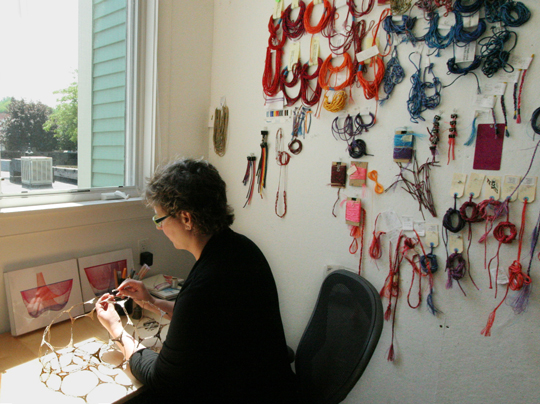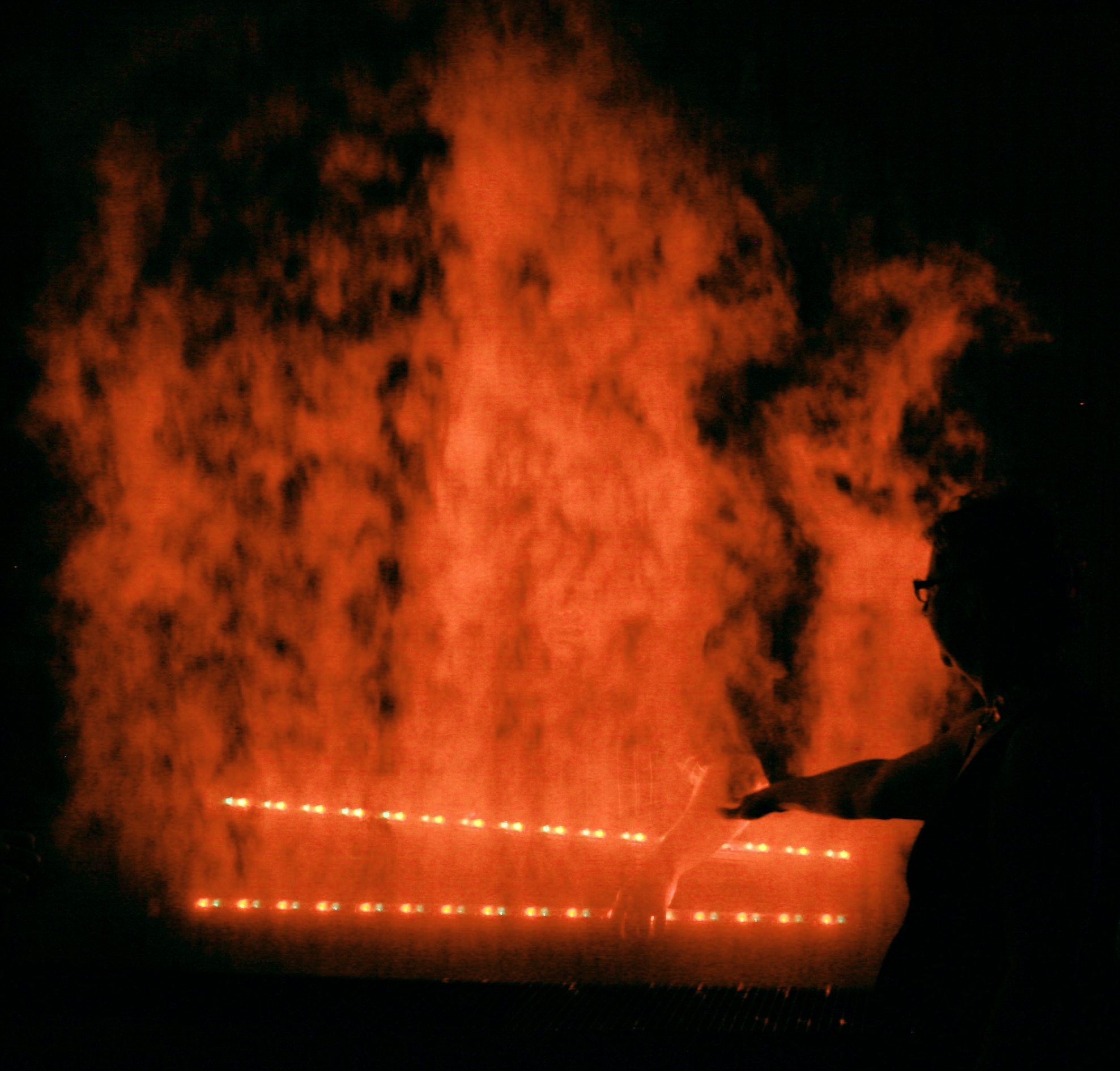While Janet Echelman was at TED in March, she got word that she was being awarded a Guggenheim Fellowship. (And in fact, Echelman wasn’t the only new Guggenheim winner speaking at TED — her fellow Session 9 speaker Fiorenzo Omenetto also won the award). The award offers her a year of time off to think and explore. The TED Blog spoke to Janet last week to find out how that’s going so far…
Let’s talk about your life since your talk at TED. What’s changed?
The Guggenheim gives me the pleasure and privilege of a sabbatical year. I’ve known that academics get sabbatical years, but as an artist, I had to figure out what that would mean for me, how I can push boundaries and take this as a time for growth. I made progress right away at TED — I was inspired by several of the people I met here. I began exploring this with the co-presenters in our TED session, “Threads of Discovery,” curated by the visionary Juan Enriquez. In our session, there were two scientists I got to know from very different fields. Fio Omenetto, who’s a silk scientist, invited me to visit his lab to meet the mechanical engineer who builds his automated silk looms. We are exploring a creative overlap that wouldn’t happen otherwise between his work and mine. And then Ed Boyden from MIT, who is working with living brain cells that can be turned on and off with light! He invited me to come over and explore collaboration. We talked about ways we could make sculpture with living cells that move and change color.
Through Ed I met several of his colleagues at the Media Lab and MIT, one of whom is Neil Gershenfeld, who’s doing some new research with a modular building technique he calls “digital composites.” And he asked me, “How could this be useful to you in doing your urban sculpture at the scale of architecture?” So we have been going back and forth, laser-cutting different shapes, bringing them to my studio, where I’ve been playing around with their potential for volumetric sculpture shapes.
I like that a meeting of different minds at TED has become a creative fulcrum.
At TED I also met Vice-President Al Gore, and we had a conversation about how ideas about the environment could take form at an urban scale, be made physical in a sculpture that people could interact with. He mentioned the climate change impact of water vapor in the atmosphere — the Clausius-Clapeyron relation. He calls it the “bathtub effect”. As the atmosphere gets warmer, it can hold more water vapor, actually pulling moisture from the soil, and then releasing it in these larger downpours. That’s a conversation that couldn’t have started anywhere else, and next week, we’re going to meet again to explore this further.
At TED, even Jason Mraz asked about my work — he asked, Could that be a place where we shoot a music video, under one of these sculptures? We’re exchanging ideas and exploring new ways for my sculpture to interact with life, through ideas and through additional cultural streams. It’s just very exciting how all these possibilities have a life of their own.
 Is this the first time you’re using laser cutting and other Fab Lab techniques in your work?
Is this the first time you’re using laser cutting and other Fab Lab techniques in your work?
Yes! One thing I really liked about the Media Lab and Neil and his grad student Kenny Cheung — they agreed with me that the best way to explore was to make something. So we laser-cut a whole bunch of components and I’m playing with them right now in my studio. Whether it moves in the wind or becomes a new kind of armature out of which something else could billow, I don’t know.
It sounds like you’re pushing limits a little bit.
In my regular life, I am very involved in commissions for cities and sometimes countries. And I think of public art as a team sport. The outcome is only possible with the interaction of all the players. It is a completely engrossing job to develop and deliver a living sculpture that will last for many years. I often have new ideas or areas that I’d like to explore, but I’m so busy in the day-to-day work of this art practice that I rarely have time to explore all those questions.
So this year with the Guggenheim Fellowship, it’s a chance to set this time apart, a time for me to explore those questions and to grow and go more deeply into new ideas. I feel lucky to be able to explore ideas that I don’t yet know are going to work. You can’t stumble upon something new and wonderful if you don’t have time to stumble.
I’m interested in pursuing original research to focus on ways of making visual the natural forces and cycles that are going on around us all the time and that we are unable to see. One way I’m doing this is exploring the possibilities of different materials. Right now I’m exploring new ways to sculpt with water. I’m testing different ways of manipulating tiny water particles to create moving curtains of “dry-mist,” and to make it thick enough so it responds and makes you want to play, yet manipulate the particles so you don’t get wet.
I like working at an urban scale, and making art that people encounter as a part of their daily life. And when it all comes together, it can become a moment of shared experience, where you might start up a conversation with a total stranger about something you are both encountering.
It’s cool, that thread in your work that is data-driven and really geeky.
One thing that has become more clear to me, actually from listening to TEDTalks about the limbic brain … I’ve always known that my work speaks to a non-verbal or pre-verbal part of ourselves, and that its communicative ability is not in the conscious part of our minds. I’ve learned that this correlates to the limbic brain, which has no language and is the part that governs how we make decisions, feel loyalty, or “gut feelings.” This helps explain why it’s always been hard for me or others to describe my work in words. It’s an experiential kind of art — about how you feel as you move through it. You take it in with your body.
This also helped me understand my process in the past couple years, working on the piece in Denver, where I took this data of an earthquake and tsunami and was inspired to make it into a visual, physical sculptural form. In the shaping of that piece, I was focused on the experience of connecting with the limbic brain, and joining it to the neocortex. So people can hook into the work through these conscious ideas, the data of the tsunami, but then it grabs you in a way that isn’t about data. Its real power is the physical experience. And that was my first project where I brought these two parts of the brain together.
Here’s another thing that came out of TED — Carl Bass and Jeff Kowalski from Autodesk heard my talk, they invited me to collaborate with their amazing software team to explore the potential for the work I’m doing with netted surfaces that move in response to wind direction and velocity.
Advances in technology have opened up possibilities in the cultural realm throughout history. I’m intrigued by developments in technology– as an artist it gives me a new palette to explore. The geeky part of me loves this exploration of technology to make art. I also want to mention the contribution of my fabulous geeky husband, David Feldman, who originally trained as a computer scientist, and now runs a firm that helps technology startups focus and unleash their potential. Even though you’d think my artwork would be the furthest thing from a technology company, I’ve learned a lot of lessons from him that have helped my art to more fully embody my ideas. He’s helped me to express and organize my ideas in context — to make sure I’m asking the right questions — which turns out to be as helpful to an artist as it is for a company.
It takes really creative collaborators from so many different fields to create this kind of urban sculpture, and it’s a real joy for me, getting to work with so many brilliant people with different kinds of minds.
Photo at top: James Duncan Davidson. All other photos: Greg Hayes / Echelman Studio



Comments (9)
Pingback: Fishnets Over Phoenix | From Bobby's Perspective
Pingback: Interview with Karim
Pingback: Echelman,斯佩蘭扎,ARUP:塞文河隧道 – YouTube的二 | 众溰梦 的分享空間
Pingback: Janet Echelman: Taking imagination seriously « Exploration Art
Pingback: Frugalis Creativus
Pingback: Imagining Creativity | piecedgoods
Pingback: Carlo Ratti: Architecture that senses and responds (TED Talks) « Mind Your Business